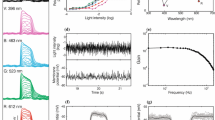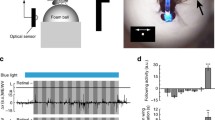Abstract
Studies on the generation of rhythmic motor patterns have shown that peripheral sensory input may contribute substantially to the rhythm generating network. A prominent example is the wing beat frequency of desert locusts, which can be entrained to rhythmic mechanosensory input, but also to the frequency of periodic light flashes. To further analyze the entrainment by light, tethered flying locusts were presented with periodic light flashes, while the position of the forewing was filmed. We show that entrainment of wing beat occurs both in the UV and green range of light. Animals maintained a characteristic phase relationship to the light stimulus with the most elevated wing position occurring at the end of the dark phase. Speed and time course of entrainment varied greatly and ranged from the duration of a single wing beat cycle to several seconds. To identify the visual system mediating entrainment, synchronization to UV light was tested after cutting the optic stalks to the optic lobes/compound eyes or the ocellar nerves. The results show that light entrainment of the locust flight pattern is largely and perhaps exclusively mediated via the fast ocellar pathway and may have a role to stabilize flight with respect to the horizon.










Similar content being viewed by others
References
Aschoff J, Wever R (1962) Über Phasenbeziehungen zwischen biologischer Tagesperiodik und Zeitgeberperiodik. Z Vgl Physiol 46:115–128
Ausborn J, Stein W, Wolf H (2007) Frequency control of motor patterning by negative sensory feedback. J Neurosci 27:9319–9328
Berger S, Kutsch W (2003) Turning manoevres in free-flying locusts: high-speed video-monitoring. J Exp Zool A299:127–138
Bergou AJ, Xu S, Wang ZJ (2007) Passive wing pitch reversal in insect flight. J Fluid Mech 591:321–337
Berry RP, Warrant EJ, Stange G (2007) Form vision in the insect dorsal ocelli: an anatomical and optical analysis of the locust ocelli. Vis Res 47:1382–1393
Briscoe AD, Chittka L (2001) The evolution of color vision in insects. Annu Rev Entomol 46:471–510
Buck J (1988) Synchronous rhythmic flashing of fireflies. II. Quart Rev Biol 63:265–289
Büschges A, Wolf H (1999) Phase-dependent presynaptic modulation of mechanosensory signals in the locust flight system. J Neurophysiol 81:959–962
Camhi JM (1970) Yaw-correcting postural changes in locusts. J Exp Biol 52:519–531
Camhi JM, Sumbre G, Wendler G (1995) Wing-beat coupling between flying locust pairs: preferred phase and lift enhancement. J Exp Biol 198:1051–1063
Dawson JW, Dawson-Scully K, Robert D, Robertson RM (1997) Forewing asymmetries during auditory avoidance in flying locusts. J Exp Biol 200:2323–2335
Dugard JJ (1967) Directional change in flying locusts. J Insect Physiol 13:1055–1063
Elson RC (1987) Integration of wing proprioceptive and descending exteroceptive sensory inputs by thoracic interneurons of the locust. J Exp Biol 128:193–217
Gewecke M (1975) The influence of the air-current sense organs on the flight behaviour of Locusta migratoria. J Comp Physiol 103:79–95
Goodman LJ, Mobbs PG, Kirkham JB (1979) The fine structure of the ocelli of Schistocerca gregaria: the neuronal organisation of the synaptic plexus. Cell Tissue Res 196:487–510
Griss C, Rowell CHF (1986) Three descending interneurons reporting deviation from course in the locust. I. Anatomy. J Comp Physiol A 158:765–774
Gueron S, Levit-Gurevich K (1998) Computation of the internal forces in cilia: application to ciliary motion, the effects of viscosity, and cilia interactions. Biophys J 74:1658–1676
Horsmann U, Heinzel HG, Wendler G (1983) The phasic influence of self-generated air current modulations on the locust flight motor. J Comp Physiol 150:427–438
Kutsch W, Camhi J, Sumbre G (1994) Close encounters among flying locusts produce wing-beat coupling. J Comp Physiol A 174:643–649
Kutsch W, van der Wall M, Fischer H (1999) Analysis of free forward flight of Schistocerca gregaria employing telemetric transmission of muscle potentials. J Exp Zool 284:119–129
Medvedev GS, Wilson CJ, Callaway JC, Kopell N (2003) Dendritic synchrony and transient dynamics in a coupled oscillator model of the dopaminergic neuron. J Comput Neurosci 15:53–69
Michaels DC, Matyas EP, Jalife J (1987) Mechanism of sinoatrial pacemaker synchronisation: a new hypothesis. Circ Res 61:704–714
Mizunami M (1994) Information processing in the insect ocellar system: comparative approaches to the evolution of visual processing and neural circuits. Adv Insect Physiol 25:151–265
Pfau HK, Nachtigall W (1981) Der Vorderflügel großer Heuschrecken als Luftkrafterzeuger. II: Zusammenspiel von Muskeln und Gelenkmechanik bei der Einstellung der Flügelgeometrie. J Comp Physiol A 142:135–140
Pikovsky A, Rosenblum M, Kurths J (2003) Synchronisation—a universal concept in nonlinear sciences. Cambridge University Press, Cambridge
Reichert H, Rowell CHF (1985) Integration of nonphaselocked exteroceptive information in the control of rhythmic flight in the locust. J Neurophysiol 53:1201–1218
Reye DN, Pearson KG (1988) Entrainment of the locust central flight oscillator by wing stretch receptor stimulation. J Comp Physiol A 162:77–89
Robertson RM, Reye DN (1992) Wing movements associated with collision-avoidance manoeuvres during flight in the locust Locusta migratoria. J Exp Biol 163:231–258
Robertson RM, Kuhnert CT, Dawson JW (1996) Thermal avoidance during flight in the locust Locusta migratoria. J Exp Biol 199:1383–1393
Rowell CHF, Pearson KG (1983) Ocellar input to the flight motor system of the locust: structure and function. J Exp Biol 103:265–288
Rowell CHF, Reichert H (1986) Three descending interneurons reporting deviation from course in the locust. II. Physiology. J Comp Physiol A 158:775–794
Schmidt J, Zarnack W (1987) The motor pattern of locusts during visually induced rolling in long-term flight. Biol Cybern 56:397–410
Simmons PJ (1980) A locust wind and ocellar brain neurone. J Exp Biol 85:281–294
Simmons PJ (1993) Adaptation and responses to changes in illumination by second- and third-order neurons of locust ocelli. J Comp Physiol A 173:635–648
Simmons PJ (2002) Signal processing in a simple visual system: the locust ocellar system and its synapses. Microsc Res Tech 56:270–280
Simmons PJ, de Ruyter van Steveninck (2005) Reliability of signal transfer at a tonically transmitting, graded potential synapse of the locust ocellar pathway. J Neurosci 25:7529–7535
Stange G (1981) The ocellar component of flight equilibrium control in dragonflies. J Comp Physiol 141:335–347
Taylor CP (1981) Contribution of compound eyes and ocelli to steering of locusts in flight. J Exp Biol 93:1–18
Taylor GK, Thomas ALR (2003) Dynamic flight stability in the desert locust Schistocerca gregaria. J Exp Biol 206:2803–2829
Waldmann B, Zarnack W (1988) Forewing movements and motor activity during roll manoeuvers in flying desert locusts. Biol Cybern 59:325–335
Waldron I (1967) Neural mechanism by which controlling inputs influence motor output in the flying locust. J Exp Biol 47:213–228
Waldron I (1968) The mechanism of coupling of the locust flight oscillator to oscillatory inputs. Z Vgl Physiol 57:331–347
Weis-Fogh T, Jensen M (1956) Biology and physics of locust flight. I. Basic principles in insect flight. A critical review. Philos Trans R Soc London B 239:415–458
Wendler G (1974) The influence of proprioceptive feedback on locust flight coordination. J Comp Physiol 88:173–200
Wilson M (1978) The functional organisation of locust ocelli. J Comp Physiol 124:297–316
Wolf H (1993) The locust tegula: significance for flight rhythm generation, wing movement control and aerodynamic force production. J Exp Biol 182:229–253
Wolf H, Pearson KG (1988) Proprioceptive input patterns flight elevator activity in the locust flight system. J Neurophysiol 59:1831–1853
Zarnack W (1972) Flugbiophysik der Wanderheuschrecke (Locusta migratoria L.). I. Die Bewegungen der Vorderflügel. J Comp Physiol 78:356–395
Acknowledgments
We thank Nicole Carey for assistance with MatLab and Richard Berry, Stanley Heinze, and Bianca Backasch for helpful discussions. This research was supported by Grants from the Air Force Office of Scientific Research, No. FA8655-08-C-3021 to U.H. and No. FA4869-06-1-0059 to G.S.
Author information
Authors and Affiliations
Corresponding author
Rights and permissions
About this article
Cite this article
Schmeling, F., Stange, G. & Homberg, U. Synchronization of wing beat cycle of the desert locust, Schistocerca gregaria, by periodic light flashes. J Comp Physiol A 196, 199–211 (2010). https://doi.org/10.1007/s00359-010-0505-9
Received:
Revised:
Accepted:
Published:
Issue Date:
DOI: https://doi.org/10.1007/s00359-010-0505-9




